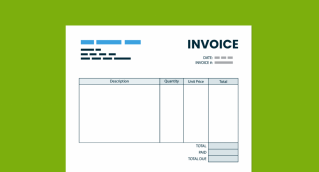Invoices: What They Are And How To Make One
Part of running a small business is making, sending, and receiving invoices. It’s like a paper trail of exchanged goods and/or services during a set period of time, almost like a receipt. The invoice lists the services completed or goods sold (or in the works), and how much is owed by the person who purchased from you, a.k.a. the buyer.
Your invoice should contain some basic components like the word INVOICE at the top; personal information,including your name/company name, address, email address, and phone number so the buyer can reach you; an invoice number to keep accurate records of invoices and when goods or services were exchanged; the date of the sold good or service; a description of the good(s) or service(s); andother helpful informationlike quantity ordered and the grand total of their order (including any taxes or discounts specified).

Invoices are typically formatted using columns in a graph format.
Remember to keep your product descriptions clear and specific. If you completed a service, name the service and provide a short description of what it entailed. If you work for an hourly rate, list how long each project takes you and how much money that equals. If you work for a flat rate and complete multiple projects, be specific to how much each project costs.
One invoice does not fit all - you’ll find that everyone has their own style invoice. There are many ways to make an invoice and can be done using various software, like Microsoft Excel or QuickBooks (they create invoices for you!). Find what works for you and stick with it for consistency. If you’d like to learn how to create invoices on QB but aren’t sure where to begin, reach out to Skynar Bookkeeping today for expert assistance on all things bookkeeping (like invoicing!).
If you would like to receive payment within a certain period of like, like within fourteen days, then it’s important to specify this somewhere on your invoice. Most invoices work under a thirty day agreement before they can be hit with fees. It’s important to set up a contract or purchase order that establishes when goods or services need to be paid for once receiving the invoice. Lay out all your payment terms for your buyers so they can’t say they didn’t know.
Always be timely with your invoicing and communicate with your buyer. Happy invoicing!
.png?token=6adcf38ed58846e4f05e97718ba6eb6d)